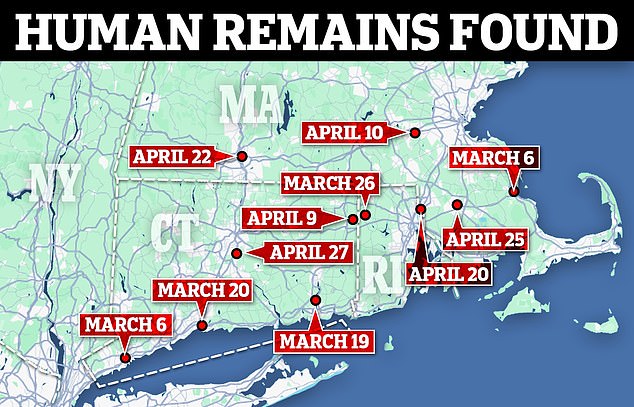It all began with a Facebook group.
Members of a true crime community started noticing multiple bodies or sets of human remains had been found across Rhode Island, Connecticut and Massachusetts.
The remains began showing up in early March and continued all throughout April.
Many of the victims were female.
Several of the discoveries were clustered close to the borders between the New England states – some just minutes driving distance apart.
Speculation and rumors quickly spread online, with thousands searching for the answer to one disturbing question: Is there a serial killer terrorizing New England?
Law enforcement agencies have gone into overdrive trying to bat away rumors of a pattern and deny any connection between the cases.
With 11 bodies found since early March, and the speculation showing no signs of dying down, America’s top serial killer experts Dr. Katherine Ramsland and Dr. Ann Burgess are sharing their thoughts on whether a serial killer could be lurking.

With 11 bodies found in two months, fears of a New England serial killer have spread online
Dr. Ramsland, professor of forensic psychology at DeSales University who studied BTK serial killer Dennis Rader and co-wrote his book, believes the fears have taken hold because the public doesn’t trust what law enforcement are saying.
She thinks that has a lot to do with what happened in the Gilgo Beach serial killer case on New York’s Long Island.
‘I think people are highly influenced by the LISK [Long Island serial killer] situation where remains were found all over the place and now they’re beginning to be connected to one individual,’ she told the Daily Mail.
‘Because of the way that investigation was poorly handled, because there were cover-ups and the FBI was shoved out, I think people are very suspicious of police handling these investigations.
‘I don’t blame them because I think that one was so egregious and embarrassing for that area, that I can understand people saying, “Well, why would we wait on the police?”’
The Gilgo Beach case – where the remains of 11 victims were found along Ocean Parkway – was notoriously hampered by law enforcement corruption in Suffolk County.
This corruption – which saw the FBI pushed off the case and ended with both top cop James Burke and District Attorney Tom Spota behind bars – has been blamed for suspected serial killer Rex Heuermann walking free for more than a decade after the first victim was found in 2010.
Because of that botched investigation, Dr. Ramsland believes social media users are taking matters into their own hands this time around.

Dr. Katherine Ramsland studied BTK serial killer Dennis Rader and co-wrote his book

Dr. Ann Burgess is known for her groundbreaking work in developing serial killer profiles
On March 6, authorities found the body of 35-year-old Paige Fannon in the Norwalk River in Norwalk, Connecticut. She was found two days after her family reported her missing.
Fannon’s was the first of the seemingly trending deaths.
That same day, a man stumbled across a human skull in the woods in Plymouth, Massachusetts.
Around two weeks later, on March 19, the torso of Suzanne Wormser, 58, was found stuffed in a suitcase in a cemetery in Groton, Connecticut.
Then, on March 20, the remains of 59-year-old Denise Leary were found close to her home in New Haven, Connecticut – six months after she allegedly vanished.
On March 26, 56-year-old Michele Romano’s body was discovered in a wooded area in Foster, Rhode Island.
As March turned into April, bodies kept showing up.
On April 9, the remains of an unidentified man aged between 25 and 45 were found in Killingly, Connecticut, with another unidentified individual found in Framingham, Massachusetts, the next day.
On April 20, around 40 miles south of Framingham, an unidentified body was found in the Seekonk River off Pawtucket, Rhode Island.

There are mounting fears that a serial killer is on the loose stalking quaint New England towns
On April 22, 45-year-old Meggan Meredith was found murdered near a bike path in Springfield, Massachusetts.
Three days later, walkers came across the body of 51-year-old Samuel Stovall in Mill River in Taunton, Massachusetts.
The next day, on April 26, 72-year-old Mary Colasanto was found in the Connecticut River in Rocky Hill, Connecticut.
As the number of bodies rose, social media users began connecting the dots, suggesting some or all of the cases could be the work of a serial killer.
A Facebook group – previously titled the New England Serial Killer – ballooned to a whopping 68,000 members within days.
Over on TikTok, videos posted by amateur sleuths and armchair detectives racked up millions of views.
Dr. Ramsland – who counts Idaho murders suspect Bryan Kohberger among her former students – says this shows the ‘nature of true crime culture these days’ and what she describes as the ‘gamesmanship in social media.’
‘There’s a lot of what I think of as fuzzy thinking going on in social media and there’s this fun about it – even though these are real victims, people are forgetting that part of it,’ she says.

Paige Fannon, 35, was found dead in the Norwalk River in Norwalk, Connecticut, on March 6
‘And there are people being accused who are innocent… So it’s not really a game, but there’s a game-like atmosphere to it.’
It’s a game that has reached such heights that Romano’s family felt forced to respond, publicly denying she died at the hands of a serial killer.
‘Take my sister Michele’s name and pictures off of this effing website right now. She was not killed by a serial killer,’ Romano’s sister Valerie posted in one Facebook group.
The wild online obsession has also driven police investigations of its own.
In April, an anonymous poster in the Facebook group shockingly confessed to the murders in bizarre poems and riddles.
Not knowing whether or not it was a hoax, police took the claims seriously.
An extensive two-day long search followed, involving multiple detectives and cadaver dogs scouring a possible gravesite along a Massachusetts beach.
Narragansett Police said it had been ‘made aware of concerning posts’ that had ‘alluded to the possibility that multiple bodies were buried in Black Point area of Scarborough Beach.’
The search came back with ‘negative results for any clandestine graves.’

The remains of Denise Leary were found close to her home in New Haven, Connecticut
In another instance, a group member shared a video purporting to show a large pool of blood inside an abandoned building.
Police again responded to the scene. The ‘blood’ turned out to be spilled iodine.
‘[Police] can’t just ignore [these claims],’ Dr. Ramsland says.
‘So that’s the game. And it’s an awful game,’ one she says has been inspired by true crime culture.
Regardless of the online conversation, there are some obvious similarities between some of the recent cases.
Many of the people found dead are women, several in their 50s.
‘I think that’s why this has become such a big deal as they do have the age range commonality,’ Dr. Ramsland says.
That said, she busts the myth that serial killers always have a type of victim.
‘Many do not, and to start with that assumption automatically gives you tunnel vision – because we might be dealing with a serial killer who doesn’t have a type,’ she says.
Taken on its own, the similarities between victims is ‘not something that would raise alarm.’

Michele Romano was found dead in Foster, Rhode Island, in March. Her family have insisted she was not killed by a serial killer
As it currently stands, both Dr. Ramsland and Dr. Burgess say it is impossible to tell if any of the dead are serial killer victims.
‘Right now, there isn’t enough information to say yay or nay,’ Dr. Burgess, known for her groundbreaking work developing serial killer profiles with the FBI’s behavioral unit, tells the Daily Mail.
‘You almost have to go case by case, then take a look at it.’
In many of the cases, it is not even clear if the person was the victim of a homicide, let alone what their cause of death was.
‘You can’t just assume all of them were murdered, and they’re all murdered by one person. That’s just silly,’ Dr. Ramsland says.
Some of the bodies still have no identity, gender or age because they were found in such a progressed state of decomposition.
Among the 11 cases, several have already been debunked as the work of a serial killer.
In late April, Wormser’s roommate Donald Coffel was charged with her murder after he allegedly bludgeoned her to death with a baseball bat, lived with her body for more than a week and then dismembered her, disposing of her body in several locations.
Separately, New Haven Police said there is no sign of foul play and no indication of any crime in Leary’s death.
Dr. Burgess says, ‘We need to keep watching, we need to see if any more bodies show up.’

Police recover the body of Samuel Stovall from the Mill River in Taunton on April 25
One thing Dr. Burgess says does raise suspicions is the number of bodies found in such a short timeframe.
‘I think what’s impressive is how many bodies they had that nobody can account for – I think that’s a little alarming that these bodies are just showing up. So where they had been or how well they had been hidden is always quite interesting.’
Both experts are cautious to point out that, while there is not enough information to indicate there is a New England serial killer, there isn’t enough information to rule it out, either.
To determine any possible linkage, they would need information on the death circumstances (once it’s confirmed a homicide) – such as how the victim died, the weapon used (if there was one) and the types of wounds.
They also would need victimology (a victim’s identity, age, gender, work life and social connections), their risk level (based on factors such as involvement in criminal activity and drug use) and their pre-death activities.
There’s also the crime scene patterns such as where the body was found and how it was left.
With that information, authorities can then see if there’s any links between cases before taking further action.
‘[In any murder], you don’t start with a serial killer or a stranger killer as your first part of the investigation… You start with people who knew [the deceased], then you go out in widening circles,’ Dr. Ramsland says.
Stranger-based homicide is always the last – and least likely – avenue to investigate.
For now, authorities continue to downplay the possibility of any links between cases in New England.
But, Dr. Ramsland says it’s likely the different agencies are comparing notes.
If links are found between any cases, agencies will put together a task force.
‘I’m sure they’re all in touch with each other,’ she says. ‘Who knows what they’re holding back from us.’

